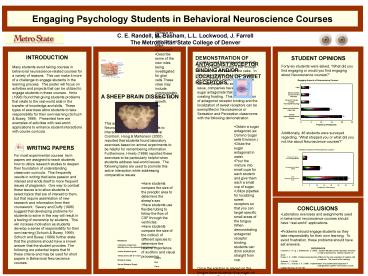Engaging Psychology Students in Behavioral Neuroscience Courses - PowerPoint PPT Presentation
1 / 1
Title:
Engaging Psychology Students in Behavioral Neuroscience Courses
Description:
Engaging Psychology Students in Behavioral Neuroscience Courses C. E. Randell, M. Basham, L.L. Lockwood, J. Farrell The Metropolitan State College of Denver – PowerPoint PPT presentation
Number of Views:140
Avg rating:3.0/5.0
Title: Engaging Psychology Students in Behavioral Neuroscience Courses
1
Engaging Psychology Students in Behavioral
Neuroscience Courses
C. E. Randell, M. Basham, L.L. Lockwood, J.
Farrell The Metropolitan State College of Denver
INTRODUCTION
DEMONSTRATION OF ANTAGONIST RECEPTOR BINDING
AND/OR LOCALIZATION OF SWEET RECEPTORS
STUDENT OPINIONS
- What is an itch?
- Why cant we tickle ourselves?
- Describe some of the new roles being investigated
for glial cells.These roles may include - communication, new cell growth,
- etc.
Forty-six students were asked, What did you find
engaging or would you find engaging about
Neuroscience courses?
Many students avoid taking courses in behavioral
neuroscience-related courses for a variety of
reasons. This can make it more of a challenge to
engage students in the learning process. This
poster will focus on activities and projects that
can be utilized to engage students in these
courses. Hmlo (1998) found that giving students
problems that relate to the real-world aids in
the transfer of knowledge and skills. These
types of exercises allow students to take
responsibility for their own learning (Schuch
Busey, 1999). Presented here are examples of
activities with real-world applications to
enhance student interactions with course
curricula.
A SHEEP BRAIN DISSECTION
- Frosting used for cakes requires high levels of
sugar to make it stiff enough to cover, but not
slide off the cake. In this concentration the
icing would be so sweet that it would be
intolerable for most people. To address this
issue, companies have developed sugar antagonists
that are used in creating frosting. This
demonstration of antagonist receptor binding and
the localization of sweet receptors can be
exemplified in Neuroscience or Sensation and
Perception classrooms with the following
demonstration - Obtain a sugar antagonist (ex Domino Sugar
sells Envision.) - Dilute the sugar antagonist in water.
- Pour the mixture into small cups for each student
and give them each a small cup of sugar. - Utilize pipettes for localizing sweet receptors
so that you can target specific small areas of
the tongue. When demonstrating antagonist
receptor binding, students can drink solution
straight from cup. - Once the solution is placed on the tongue have
students drop sugar on the tongue. Students
should experience little or no sweet taste from
the sugar. Students will be able to experience
first hand antagonistic blocking of the sweet
receptors on their tongue!
- This activity engages students in Neuroanatomy
and allows students to interact actively with
course material. Cronhom, Hoog Martenson
(2000) reported that students found laboratory
exercises based on animal experiments to be
helpful for remembering information.
Furthermore, Hmelo (1998) reported these
exercises to be particularly helpful when
students address real-world issues. The
following tasks are used to promote this active
interaction while addressing comparative issues - Have students compare the size of the preoptic
area to determine the sheeps sex. - Have students use flexible tubing to follow the
flow of CSF through the ventricles. - Have students compare the size of the colliculi
of different species to determine the relative
importance of auditory and visual processing.
Additionally, 46 students were surveyed
regarding, What stopped you or what did you not
like about Neuroscience courses?
WRITING PAPERS
For most experimental courses term papers are
assigned to teach students how to utilize
research studies to deepen their foundation of
understanding classroom curricula. This
frequently results in writing that lacks passion
and interest and lends itself to more frequent
issues of plagiarism. One way to combat these
issues is to allow students to select topics that
are of interest to them, but that require
assimilation of new research and information from
their coursework. Savery and Duffy (1996)
suggest that developing problems for students to
solve in this way will result in a feeling of
ownership by students. This will increase
motivation as students develop a sense of
responsibility for their own learning (Schuch
Busey, 1999). Schuch and Busey (1999) further
state that the problems should have a known
answer that the student provides. The following
are potential topics that fit these criteria and
may be used for short papers in Behavioral
Neuroscience courses.
CONCLUSIONS
- Laboratory exercises and assignments used in
behavioral neuroscience courses should have
real-world applications. - Problems should engage students so they take
responsibility for their own learning. To avoid
frustration, these problems should have set
answers.
Resources ?interactive sheep brain
atlashttp//www.msu.edu/user/brains/sheepatlas/ ?
online dissection guide http//academic.uofs.edu/d
epartment/psych/sheep/ ?Sheep brains (6- 11
each) Carolina Biological Supply Blue Spruce
Biological Supply Fisher Scientific
REFERENCES Cronholm, T., HÖÖg, J. Mårtenson, D.
(2000). Student attitudes towards laboratory
exercises in medical biochemistry. Medical
Teacher, 22, 30-33. Hmelo, C. E. (1998).
Problem-based learning Effects on the early
acquistion of cognitive skill in medicine. The
Journal of the Learning Sciences, 7,
173-208. Schuch, K. L. Busey, T. A. (1999).
Implementation of a problem-based approach in
undergraduate cognitive neuroscience course.
College Teaching, 49, 153-159.































